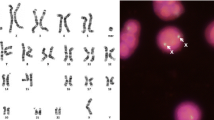Abstract
The identification of marker chromosomes in clinical and tumor cytogenetics by chromosome banding analysis can create problems. In this study, we present a strategy to define minute chromosomal rearrangements by multicolor fluorescence in situ hybridization (FISH) with “whole chromosome painting” probes derived from chromosome-specific DNA libraries and Alu-polymerase chain reaction (PCR) products of various region-specific yeast artificial chromosome (YAC) clones. To demonstrate the usefulness of this strategy for the characterization of chromosome rearrangements unidentifiable by banding techniques, an 8p+ marker chromosome with two extra bands present in the karyotype of a child with multiple anomalies, malformations, and severe mental retardation was investigated. A series of seven-color FISH experiments with sets of fluorochrome-labeled DNA library probes from flow-sorted chromosomes demonstrated that the additional segment on 8p+ was derived from chromosome 6. For a more detailed characterization of the marker chromosome, three-color FISH experiments with library probes specific to chromosomes 6 and 8 were performed in combination with newly established telomeric and subtelomeric YAC clones from 6q25, 6p23, and 8p23. These experiments demonstrated a trisomy 6pter→6p22 and a monosomy 8pter→8p23 in the patient. The present limitations for a broad application of this strategy and its possible improvements are discussed.
Similar content being viewed by others
References
Collins CC, Kuo WL, Segraves R, Fuscoe JC, Pinkel D, Gray JW (1991) Construction and characterization of plasmid libraries enriched in sequences from single human chromosomes. Genomics 11:997–1006
Dauwerse JG, Wiegant J, Raap AK, Breuning MH, Ommen GJB van (1992) Multiple colors by fluorescence in situ hybridization using ratio-labelled DNA probes create a molecular karyotype. Hum Mol Genet 1:593–598
Dutrillaux B, Couturier J, Richer CL, Viegas-Pequinot E (1976) Sequence of DNA replication in 277 R- and Q-bands of human chromosomes using a BrdU treatment. Chromosoma 58:51–61
Grouchy J de, Turleau C (1984) Clinical atlas of human chromosomes, 2nd edn. Wiley, New York
Heslop-Harrison JS, Harrison GE, Leitch IJ (1992) Reprobing of DNA:DNA in situ hybridization preparations. Trends Genet 8:372–373
IJdo JW, Lindsay EA, Wells RA, Baldini A (1992) Multiple variants in subtelomeric regions of normal karyotypes. Genomics 14:1019–1025
Johnson GD, Nogueira Araujo GM de C (1981) A simple method of reducing the fading of immunofluorescence during microscopy. J Immunol Methods 43:349–350
Kallioniemi A, Kallioniemi OP, Sudar D, Rutovitz D, Gray JW, Waldman F, Pinkel D (1992) Comparative genomic in situ hybridization for molecular cytogenetic analysis of solid tumors. Science 258:818–821
Ledbetter DH (1992a) Minireview: cryptic translocations and telomere integrity. Am J Hum Genet 51:451–456
Ledbetter DH (1992b) The “colorizing” of cytogenetics: is it ready for prime time? Hum Mol Genet 1:297–299
Lengauer C, Green ED, Cremer T (1992) Fluorescence in situ hybridization of YAC clones after Alu-PCR amplification. Genomics 13:826–828
Lengauer C, Speicher MR, Popp S, Jauch A, Taniwaki M, Nagaraja R, Riethman HC, Donis-Keller H, d'Urso M, Schlessinger D, Cremer T (1993) Chromosomal bar codes produced by multicolor fluorescence in situ hybridization with multiple YAC clones and whole chromosome painting probes. Hum Mol Genet 2:505–512
Lichter P, Cremer T (1992) Chromosome analysis by non-isotopic in situ hybridization. In: Rooney DE, Czepulkowski BH (eds) Human cytogenetics — a practical approach, vol F, 2nd edn. IRL Press, Oxford, pp 157–192
Lichter P, Boyle AL, Cremer T, Ward DC (1991) Analysis of genes and chromosomes by nonisotopic in situ hybridization. Genet Anal Techn Appl 8:24–35
Manoir S du, Speicher MR, Joos S, Schröck E, Popp S, Döhner H, Kovacs G, Robert-Nicoud M, Lichter P, Cremer T (1993) Detection of complete and partial chromosome gains and losses by comparative genomic in situ hybridization. Hum Genet 90:590–610
Nederlof PM, Flier S van der, Wiegant J, Raap AK, Tanke HJ, Ploem JS, Ploeg M van der (1990) Multiple fluorescence in situ hybridization. Cytometry 11: 126–131
Nederlof PM, Flier S van der, Vrolijk J, Tanke HJ, Raap AK (1992) Fluorescence ratio measurements of double-labeled probes for multiple in situ hybridization by digital imaging microscopy. Cytometry 13:839–845
Pinkel D, Gray JW, Trask B, Engh G van den, Fuscoe J, Dekken H van (1986) Cytogenetic analysis by in situ hybridization with fluorescently labeled nucleic acid probes. Cold Spring Harb Symp Quant Biol 51:151–157
Ried T, Baldini A, Rand TC, Ward DC (1992a) Simultaneous visualization of seven different DNA probes by in situ hybridization using combinatorial fluorescence and digital imaging microscopy. Proc Natl Acad Sci USA 89:1388–1392
Ried T, Landes G, Dackowski W, Klinger K, Ward DC (1992b) Multicolor fluorescence in situ hybridization for the simultaneous detection of probe sets for chromosomes 13, 18, 21, X and Y in uncultured amniotic fluid cells. Hum Mol Genet 1:307–313
Ried T, Lengauer C, Cremer T, Wiegant J, Raap AK, Ploeg M van der, Groitl P, Lipp M (1992c) Specific metaphase and interphase detection of the breakpoint region in 8q24 of Burkitt lymphoma cells by triple-color fluorescence in situ hybridization. Genes Chrom Cancer 4:1–6
Sambrook J, Fritsch EF, Maniatis T (1989) Molecular cloning: a laboratory manual, 2nd edn. Cold Spring Harbor Laboratory, Cold Spring Harbor, NY
Telenius H, Pelmear AH, Tunnacliffe A, Carter NP, Behmel A, Ferguson-Smith MA, Nordenskjöld M, Pfragner R, Ponder BAJ (1992) Cytogenetic analysis by chromosome painting using DOP-PCR amplified flow-sorted chromosomes. Genes Chrom Cancer 4:257–263
Wiegant J, Ried T, Nederlof PM, Ploeg M van der, Tanke HJ, Raap AK (1991) In situ hybridization with fluoresceinated DNA. Nucleic Acids Res 19:3237–3241
Author information
Authors and Affiliations
Additional information
Dedicated to Professor Dr. U. Wolf on the occasion of his 60th birthday
Rights and permissions
About this article
Cite this article
Popp, S., Jauch, A., Schindler, D. et al. A strategy for the characterization of minute chromosome rearrangements using multiple color fluorescence in situ hybridization with chromosome-specific DNA libraries and YAC clones. Hum Genet 92, 527–532 (1993). https://doi.org/10.1007/BF00420933
Received:
Revised:
Issue Date:
DOI: https://doi.org/10.1007/BF00420933




